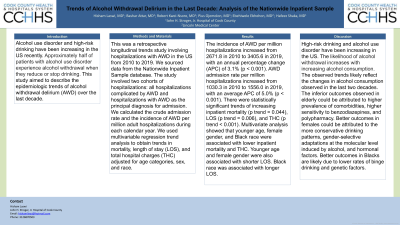Back


Poster Session C - Monday Afternoon
Category: Liver
C0527 - Trends of Alcohol Withdrawal Delirium in the Last Decade: Analysis of the Nationwide Inpatient Sample
Monday, October 24, 2022
3:00 PM – 5:00 PM ET
Location: Crown Ballroom

Has Audio
- HL
Hisham Laswi, MD
John H. Stroger, Jr. Hospital of Cook County
Chicago, IL
Presenting Author(s)
Hisham Laswi, MD1, Bashar Attar, MD1, Robert Kwei-Nsoro, MD1, Pius E. Ojemolon, MD1, Ebehiwele Ebhohon, MD, MPH2, Hafeez Shaka, MD1
1John H. Stroger, Jr. Hospital of Cook County, Chicago, IL; 2Lincoln Medical and Mental Health Center, Bronx, NY
Introduction: Alcohol use disorder and high-risk drinking have been increasing in the US recently. Approximately half of patients with alcohol use disorder experience alcohol withdrawal when they reduce or stop drinking. This study aimed to describe the epidemiologic trends of alcohol withdrawal delirium (AWD) over the last decade.
Methods: This was a retrospective longitudinal trends study involving hospitalizations with AWD in the US from 2010 to 2019. We sourced data from the Nationwide Inpatient Sample database. The study involved two cohorts of hospitalizations: all hospitalizations complicated by AWD and hospitalizations with AWD as the principal diagnosis for admission. We calculated the crude admission rate and the incidence of AWD per million adult hospitalizations during each calendar year. We used multivariable regression trend analysis to obtain trends in mortality, length of stay (LOS), and total hospital charges (THC) adjusted for age categories, sex, and race.
Results: The incidence of AWD per million hospitalizations increased from 2671.8 in 2010 to 3405.6 in 2019, with an annual percentage change (APC) of 3.1% (p < 0.001). AWD admission rate per million hospitalizations increased from 1030.3 in 2010 to 1556.0 in 2019, with an average APC of 5.0% (p < 0.001). There were statistically significant trends of increasing inpatient mortality (p trend = 0.044), LOS (p trend = 0.006), and THC (p trend < 0.001). Multivariate analysis showed that younger age, female gender, and Black race were associated with lower inpatient mortality and THC. Younger age and female gender were also associated with shorter LOS. Black race was associated with longer LOS.
Discussion: High-risk drinking and alcohol use disorder have been increasing in the US. The likelihood of alcohol withdrawal increases with increasing alcohol consumption. The observed trends likely reflect the changes in alcohol consumption observed in the last two decades. The inferior outcomes observed in elderly could be contributed to higher prevalence of comorbidities, higher sensitivity to benzodiazepines, and polypharmacy. Better outcomes in females could be attributed to the more conservative drinking patterns, gender-selective adaptations at the molecular level induced by alcohol, and hormonal factors. Better outcomes in Blacks are likely due to lower rates of binge drinking and genetic factors.
Disclosures:
Hisham Laswi, MD1, Bashar Attar, MD1, Robert Kwei-Nsoro, MD1, Pius E. Ojemolon, MD1, Ebehiwele Ebhohon, MD, MPH2, Hafeez Shaka, MD1. C0527 - Trends of Alcohol Withdrawal Delirium in the Last Decade: Analysis of the Nationwide Inpatient Sample, ACG 2022 Annual Scientific Meeting Abstracts. Charlotte, NC: American College of Gastroenterology.
1John H. Stroger, Jr. Hospital of Cook County, Chicago, IL; 2Lincoln Medical and Mental Health Center, Bronx, NY
Introduction: Alcohol use disorder and high-risk drinking have been increasing in the US recently. Approximately half of patients with alcohol use disorder experience alcohol withdrawal when they reduce or stop drinking. This study aimed to describe the epidemiologic trends of alcohol withdrawal delirium (AWD) over the last decade.
Methods: This was a retrospective longitudinal trends study involving hospitalizations with AWD in the US from 2010 to 2019. We sourced data from the Nationwide Inpatient Sample database. The study involved two cohorts of hospitalizations: all hospitalizations complicated by AWD and hospitalizations with AWD as the principal diagnosis for admission. We calculated the crude admission rate and the incidence of AWD per million adult hospitalizations during each calendar year. We used multivariable regression trend analysis to obtain trends in mortality, length of stay (LOS), and total hospital charges (THC) adjusted for age categories, sex, and race.
Results: The incidence of AWD per million hospitalizations increased from 2671.8 in 2010 to 3405.6 in 2019, with an annual percentage change (APC) of 3.1% (p < 0.001). AWD admission rate per million hospitalizations increased from 1030.3 in 2010 to 1556.0 in 2019, with an average APC of 5.0% (p < 0.001). There were statistically significant trends of increasing inpatient mortality (p trend = 0.044), LOS (p trend = 0.006), and THC (p trend < 0.001). Multivariate analysis showed that younger age, female gender, and Black race were associated with lower inpatient mortality and THC. Younger age and female gender were also associated with shorter LOS. Black race was associated with longer LOS.
Discussion: High-risk drinking and alcohol use disorder have been increasing in the US. The likelihood of alcohol withdrawal increases with increasing alcohol consumption. The observed trends likely reflect the changes in alcohol consumption observed in the last two decades. The inferior outcomes observed in elderly could be contributed to higher prevalence of comorbidities, higher sensitivity to benzodiazepines, and polypharmacy. Better outcomes in females could be attributed to the more conservative drinking patterns, gender-selective adaptations at the molecular level induced by alcohol, and hormonal factors. Better outcomes in Blacks are likely due to lower rates of binge drinking and genetic factors.
Disclosures:
Hisham Laswi indicated no relevant financial relationships.
Bashar Attar indicated no relevant financial relationships.
Robert Kwei-Nsoro indicated no relevant financial relationships.
Pius Ojemolon indicated no relevant financial relationships.
Ebehiwele Ebhohon indicated no relevant financial relationships.
Hafeez Shaka indicated no relevant financial relationships.
Hisham Laswi, MD1, Bashar Attar, MD1, Robert Kwei-Nsoro, MD1, Pius E. Ojemolon, MD1, Ebehiwele Ebhohon, MD, MPH2, Hafeez Shaka, MD1. C0527 - Trends of Alcohol Withdrawal Delirium in the Last Decade: Analysis of the Nationwide Inpatient Sample, ACG 2022 Annual Scientific Meeting Abstracts. Charlotte, NC: American College of Gastroenterology.
